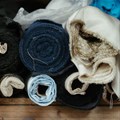Greening the global textile value chain

As the director of fashion brands at Bluesign Technologies, he works closely with designers, manufacturers and brands across the globe, equipping them with the knowledge to embark or progress on a meaningful sustainability journey.
Saritosun will be sharing some of his insights on sustainable textile development in a panel discussion at the Zone 22 Rotary Africa Centennial International Conference taking place this weekend on 24 and 25 April.
Ahead of the event, and in light of Fashion Revolution Week being observed between 19 and 25 April, we chatted to Saritosun to hear his thoughts on sustainable textile development, supply chain transparency and what it takes to build a fashion industry that's kinder to the Earth.
As the director of fashion brands at Bluesign Technologies, tell us a bit more about the focus of your work…
Sure. Founded in 2000 in Switzerland, Bluesign is a leading service organisation providing solutions to the entire fashion value chain for sustainable textile manufacturing. With its holistic approach based on input stream management, the Bluesign system reduces the impact on people and the environment through responsible use of resources, responsible production, eliminating hazardous substances from the beginning, and thus providing the highest level of consumer safety both for the brands and the consumers.
With over 660 Bluesign system partner chemical suppliers, manufacturers and brands, Bluesign connects the global fashion value chain around transparency, traceability and excellence in sustainable textile production.
In my role as director of fashion brands, I am responsible for educating the fashion brands on environmental management and safe chemistry, helping them in their journey towards excellence in sustainability. It is important to mention that sustainability is a journey, it is all about continuous improvement.
Whether you are a big or small brand, it is important to set goals, measure improvement and build upon your achievements to move on with the next set of goals. There is no such thing as 100% sustainable, so instead of getting bogged down with giant projects, brands can progress one step at a time. Be courageous, take risks.
Could you unpack what ‘sustainable textile development’ means to you, and how it relates to the broader textile value chain?
The globally accepted definition of sustainable development based on the 1987 Brundtland Report is “Development that meets the needs of the present without compromising the ability of future generations to meet their own needs”. The fashion industry is not the cleanest industry in the world and has a substantial environmental and social impact, as well as using a lot of natural resources, from water to land.
It is estimated that we will be 8.5 billion people on planet Earth by 2030 and that means billions and billions of more clothing produced and consumed. This has a massive environmental and also social impact.
A list of the issues that need to be addressed are:
• Use of natural resources, especially water: The water consumption in the textile industry, starting from growing the raw materials to fabric and garment production, is very high. 2,700 litres of water is required to grow enough conventionally-farmed cotton (organic cotton is irrigated by rain) to make just one t-shirt!
• Use of fossil-fuel-based materials: Based on the Preferred Fiber and Materials Market Report 2020 published by the organisation Textile Exchange in 2019, 52% of the global fibre production was polyester. And the market share of recycled polyester was 14% in 2019. This is a heavy reliance on petroleum-based raw materials. We need to look into ways to increase the uptake of recycled polyester or move away from petroleum-based fibres.
• Use of toxic chemicals: Insecticides, pesticides growing conventional cotton. According to an article in the Guardian newspaper, around 8,000 synthetic chemicals are used in the textile industry, however safe alternatives are available.
• Waste generation: 160 kgs of apparel is discarded for every man, child and woman in the US only. Ninety-five percent of this waste in the US could be recycled or reused. Brands are embarking on a circular business model to reuse, recycle, re-sell garments, but this needs to be at a greater scale. Circularity is the business model for a more sustainable future given the amount of production, consumption and waste generated.
• Climate impact: Fabric production has a high CO2 footprint. Consulting company McKinsey & Company partnered with the sustainability advocacy organisation Global Fashion Agenda for the 2020 report, Fashion on Climate. Based on this report, the global apparel and footwear industry produced more greenhouse gases than France, Germany and the UK combined in 2018, totalling 2.1 billion tonnes of CO2 emissions – approximately 4% of total global emissions.
• Social impact: According to the Pulse of Fashion Industry Report 2017 published by Global Fashion Agenda, 34% of the employment is in the textile industry in key Asian manufacturing countries and 60% to 80% of exports are from the apparel industry in some developing countries where manufacturing takes place. So it's a big driving force.Eighty percent of the workforce in the apparel industry in these countries are women. There are issues with gender equality regarding pay, modern slavery and child labour both at the farm level and at the manufacturing facilities.
In your view, what are the current main threats to the development of a sustainable fashion industry?
The amount of production and consumption. Once fast fashion was introduced and became mainstream, clothing became disposable. This take-make-dispose model needs to move into a circular model through which the clothing that is already produced with a lot of resources stay in the economy much longer, getting a second, third and fourth life.
The level of commitment is also a threat since to be able move the needle at a global scale to be able to make the necessary positive impact, for instance to curb global warming, we need to have the brands really step up with achieving their sustainability targets. This is not a “nice to have”, it is a “must have” as we do not have a Plan B when it comes to planet Earth.
Governments started to put in legislation regarding sustainable textiles and fashion, and this is one way to push the brands in the right direction. I keep saying brands, as they are the top of the fashion value chain and dictate what happens in their supply chain or what actions need to be taken for positive impact.
Can you pinpoint a few fashion companies that you feel are positively impacting the sustainable and ethical fashion movement?
With regards to sustainable fashion, Patagonia and Eileen Fisher have been leading the pack for over a decade now. Mara Hoffman and Stella McCartney are the other brands I can mention out of many others. In terms of African brands Anyango Mpinga from Kenya, Lisa Folawiyo from Nigeria, and South Africa's Sinsido Khumalo are the sustainable fashion brands I follow as well.
There’s been a push to make fashion supply chains more transparent. How do feel about the progress being made in this area?
Transparency is a double-edged sword as these days you are expected to be transparent and share information as brand, especially demanded by Gen Z and the Millennials. However, the downside of this is that there are all these people out there that turn around and tell a brand “Well you say that you are improving your water consumption in your supply chain, but how about this other aspect? Are you doing enough about this, or that?” So I see that some brands are being cautious about how much information they share due to this potential backlash.
However, I strongly believe that they need to communicate to their consumer the initiatives and the achievement to educate them, tell them where they are in their journey and where they want to go. San Francisco-based US brand Everlane has been doing a fantastic job in being transparent about who their suppliers are, how much the garment actually costs to them, and they also tell the story behind their suppliers. It is all on their website.
Consumer education is key, especially when it comes to the true cost of sustainability. Brands have a huge responsibility in this education. If you are buying a pair of jeans for €4.99 at regular retail price, there is no way that pair of jeans could have been produced sustainably as there is a certain cost associated with sustainable materials, safe chemistry, installing the right production systems to minimise environmental impact, all of which would get reflected in the retail price. And that price would not be €4.99.
Do you think that the Covid-19 pandemic has helped or hindered progress when it comes to the sustainable development of the fashion industry?
The pandemic really showed us the soft belly of the fashion industry when it comes to partnerships in the supply chain and how brands approach these partnerships. There were many many instances where brands stopped finished goods shipments or stopped the production of half-finished garments, cancelling the orders overnight. This was a huge burden on the suppliers’ shoulders who already paid for all the materials to make these garments.
So partnerships in the fashion value chain has been discussed a lot since the beginning of the pandemic and allowed a healthy discussion on what true partnership means, and that it's not a one-way street. The pandemic also revealed to a lot of brands and manufacturers that putting all the right practices in place with regards to sustainability is the only way they can weather another crisis like this. So although, Covid caused a once in a 100 year devastating disruption in the fashion industry, it was also an eye-opener to move forward with improvements in their sustainability practices.
How do you think innovative ‘textiles of the future’ will differ from the textiles we’re familiar with today?
We have been going through some very exciting times the last couple years with regards to new innovations in sustainable material development. Today’s designers have so much more choice available to them; they have a much larger playground compared to what we had 10 years ago.
Man-made cellulosics such as Tencel from the Austrian fibre company Lenzing is made from sustainably-sourced wood chips, produced in a "closed-loop system," in which 99% of the chemicals and solvents used in the process to break down the wood pulp are recovered and recycled with minimal waste and very low emissions. It does not require insecticides or pesticides and uses a lot less land and water than conventional cotton. Also, it's breathable and soft, a great cotton alternative.
There are new innovations such as non-animal leather made from mycelium (the root network of mushrooms), materials produced from food waste such as citrus and pineapples, and the technology exists to produce artificial spider silk to turn into silk-like materials. Even ocean kelp is being used to make into fibres and fabrics. Discarded garments and textile waste can now be chemically recycled into new fibres and fabrics.
All of this will help us move away from traditional textile crops which use a lot of natural resources and land. The key here is to get the big brands to support these innovations, and use them in their collections so that the production of these materials can be scaled up and not stay a “lab experiment”. I especially say “big brands” here as the production volume of these brands are billions of garments so their uptake of these new materials is especially important for these innovations to become mainstream materials.














































